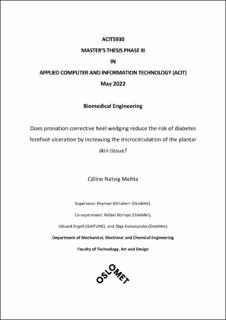| dc.description.abstract | Development of foot ulcers is a known risk in patients with diabetes mellitus, mainly due to atherosclerosis and neuropathy. Though a few national and international guidelines recommend pronation corrective footwear for overpronating diabetes patients, there is a paucity of evidence for such a recommendation. The purpose of this study is to assess the effect of heel wedged pronation corrective footwear on the plantar microcirculation to determine whether they may have a preventive effect on the development of foot ulcers. The forefoot microcirculatory flux, or laser Doppler blood flow, was assessed on medial and lateral sides using Laser Doppler Flowmetry sensors. The effect of the medially wedged footwear was compared to flat and laterally wedged footwear. The experiment protocol was carried out on four overpronating non-diabetic subjects with no prior history of foot ulceration. The study revealed that medially wedged sandals resulted in higher flux level relative to flat sandal flux on the medial side of the forefoot (188%, SD = 132%), and that laterally wedged sandals resulted in higher relative flux on the lateral side (216%, SD=188%) during relaxed bipedal stance. The relative flux levels during foot elevation after stance show the opposite trend, indicating increased post-compression reperfusion hypothesized to be related to increased degree of hypoperfusion, thus an indirect measure coinciding with the previous finding.
The findings suggest that the degree of pronation in a subject presents a pressure-dependent vascular hypoperfusion during stance. It also suggests that the medial sole has a positive effect in the offloading of the first metatarsal head, an area with a high frequency of ulcerations, albeit at the expense of decreased flux on the lateral side of the forefoot (78%, SD=25%). However, the lateral flux increased from the flat sole to both the medial and lateral wedge, indicating either that compression is not the main factor in microcirculatory blood flow, or, more likely, as also seen by the large standard deviations, that more large scale studies are needed | en_US |
